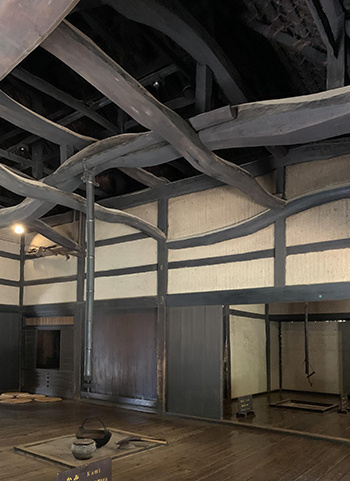

千葉九十九里の網元の家、その3です。
全国各地の古建築を収集し続けたのは当時の川崎市長のプランとのこと。
こういう「民俗」保全に公的な取り組みが果たした役割は大きい。
住宅にはその地域の経済社会の総体がさまざまに刻印されていく。
現代社会での規格大量生産型住宅ではあり得ないような民俗性表現に
その時代を読み解くさまざまな情報がピンナップされると思います。
それを手掘りすることで、いまの家づくり、生き方にも示唆が得られる。
よくこうした民家園ではこどもたちの「社会学習」が催事される。
非常に素晴らしいことだと思います。
フランスでは教育の一環で住教育があるとされますが、
日本でもこうした古民家群にはそういう機縁・可能性が濃厚。
純粋なこどもたちの感受性に先人たちの生き様が伝わって欲しい・・・。


きのうこの家の最大の「見せ場」、飛龍のような軸組の豪放さを紹介した。
やはりというか、多くのみなさんから注目されたようで、
とくに現代住宅との対比において、大工棟梁と大工たちのものづくりの姿勢に
大いに感銘を受けられたように思いました。
あんな曲がり材、暴れ放題の材を知恵と技を集中して仕上げる。
そういう表現の迫力を、とくに子どもたちに感じてもらいたい。
ひとが仕事を通してなにをできるのか、
そんな先人たちのいのちの叫び声が感じられると思われるのです。
ともすれば「お金を儲ける」ことが人生の主目的になってしまう現代。
しかし、先人たちは仕事を通してはるかに大切なものを教えてくれている。
本日紹介の網元家の写真は座敷空間と「風呂・厠」。
この家は「作田家」住居。作田家というのは現在の地名としても残る。
この地域の名主も務める上層家系にして地域経済の主宰者。
大地引き網漁を営んでいて、網船2艘を使う大がかりなもので、
船方70人と岡者と呼ばれる網を引くときだけ手伝う農民も含めて
200人以上の労働力を動員する地域を挙げた「大企業」。
船大工、鍛冶屋、網職人、鰯加工業者まで傘下に抱えていたという。
船大工は素性の異なる木材への深い技術洞察と読者の方から指摘も。
「カミ」空間の飛龍軸組との技術的な連関があったかどうか。
作田家の主な漁獲物はイワシで、干鰯(ほしか)や〆粕(しめかす)といった
農業肥料にされたといわれます。これは江戸期を通じて発展した
京都のファッション産業の主原料・綿栽培の基礎になった生産物。
ちょうどこの時期、北海道でもニシン漁がさかんになるけれど、
同様の需要に充てられた。江戸期の消費経済循環の重要な側面ですね。
作田家の主人は「ダンナサマ」妻は「ジョウサマ」と尊称された。
ジョウサマほか、作田家の女性は外出に駕籠を使用したとのこと。
地引き網で大漁になると、ハダカの漁夫がジョウサマへ
走って駆けつけて報告するという「しきたり」が伝承されていたとのこと。
なにやら、民俗として生々しさが感じられる。


江戸期は武士階級は支配者ではあっても、経済活動にはほぼ関与しない。
したがって、このような上層庶民が経済をすべて動かしていた。
地域にとって経済のほぼ全てを掌握する存在。
武家住宅のように格式的ではないけれど、この写真のような
ゲンカン・中の間・奥という3間取りという座敷空間が上層生活ゾーン。
ふろばとかわやは別棟で縁伝いに本家建物と接続されていた。
English version⬇
[Edo period large business owner, Amimoto’s house / Japanese good house ⑲-3]
In France, education is education. Even in Japan, there is plenty of potential for old folk houses. The way of life of the ancestors to the sensitivity of children.・ ・ ・
Amimoto’s house in Kujukuri, Chiba, part 3.
It was the plan of the mayor of Kawasaki at that time to continue collecting old buildings from all over the country.
Public efforts have played a major role in such “folk” conservation.
The housing is imprinted with various imprints of the economy and society of the region.
Standards in modern society For folklore expressions that cannot be achieved in mass-produced houses
I think that various information to understand the era will be pinned up.
By digging it by hand, you can get suggestions for the current way of building and living.
Children’s “social learning” is often held in these private houses.
I think it’s very nice.
In France, it is said that there is housing education as part of education,
Even in Japan, there are many such opportunities and possibilities for these old folk houses.
I want the lives of our predecessors to be conveyed to the sensitivities of pure children.
I introduced the biggest “showing place” of yesterday’s house, the extravagance of the framework like Hiryu.
After all, it seems that many people have paid attention to it.
Especially in comparison with modern houses, the attitude of carpenters and carpenters in manufacturing
I was very impressed.
We concentrate our wisdom and skill to finish such bending materials and all-you-can-eat materials.
I especially want children to feel the power of such expressions.
What can a person do through work?
It seems that you can feel the cry of life of such predecessors.
Nowadays, “making money” is the main purpose of life.
However, the ancestors teach us something much more important through their work.
The photo of the Amimoto family introduced today is a tatami room and a “bath / kitchen”.
This house is the “Sakuta family” residence. The Sakuta family remains as the current place name.
A high-ranking family who also serves as the head of the region and the head of the local economy.
It is a large-scale fisherman who runs seine fishing and uses two net boats.
Including 70 people on the boat and farmers who help only when pulling a net called Oka
A “large company” that lists areas that mobilize a labor force of more than 200 people.
It is said that ship carpenters, blacksmiths, net craftsmen, and sardine processors were all under the umbrella.
Ship carpenters have deep technical insights into wood with different backgrounds and readers point out.
Whether there was a technical connection with the Hiryu framework in the “Kami” space.
The main catch of the Sakuta family is sardines, such as dried sardines and sardines.
It is said to have been used as agricultural fertilizer. This developed throughout the Edo period
The product that became the basis of cotton cultivation, the main raw material for the fashion industry in Kyoto.
At this time of year, herring fishing is becoming more popular in Hokkaido,
It was devoted to similar demand. This is an important aspect of the consumer economic cycle during the Edo period.
The owner of the Sakuta family was hailed as “Danna Sama” and his wife was honored as “Josama”.
It is said that Josama and other women from the Sakuta family used Kago to go out.
When a big catch is made with a seine net, a Hadaka fisherman goes to Josama
It is said that the “custom” of running, rushing and reporting was handed down.
Somehow, it feels fresh as a folklore.
Although the samurai class was the ruler during the Edo period, it was hardly involved in economic activities.
Therefore, these high-ranking people were driving the economy altogether.
Existence that controls almost all of the economy for the region.
It’s not as formal as a samurai house, but like this picture
The upper living zone is a tatami room with 3 floor plans: Genkan, Nakama, and Oku.
Furoba and Kawaya were connected to the main building in a separate building.
Posted on 1月 24th, 2021 by 三木 奎吾
Filed under: 住宅マーケティング, 日本社会・文化研究







コメントを投稿
「※誹謗中傷や、悪意のある書き込み、営利目的などのコメントを防ぐために、投稿された全てのコメントは一時的に保留されますのでご了承ください。」
You must be logged in to post a comment.